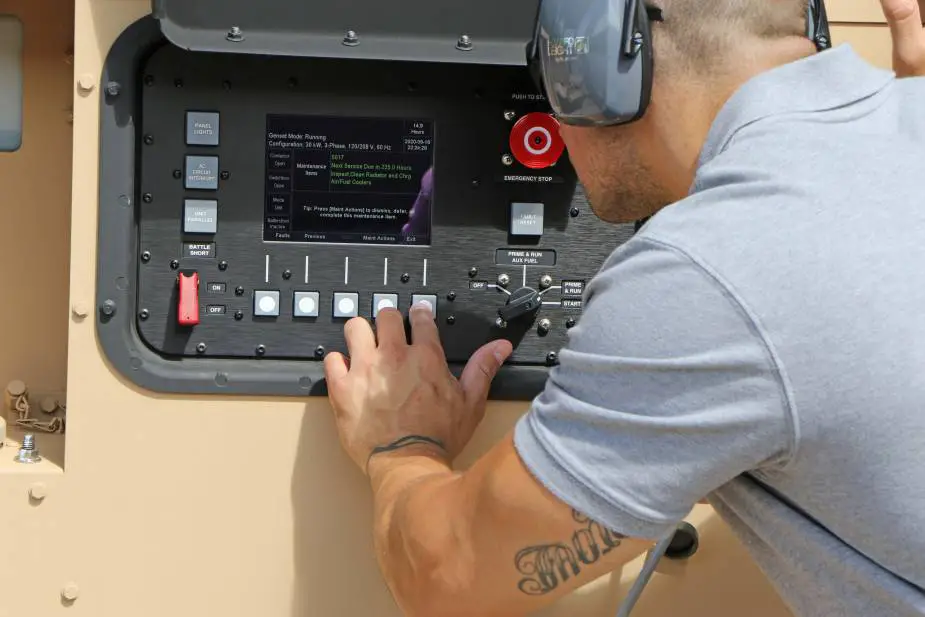US DOD demonstrates mobile microgrid technology
The Office of the U.S. Undersecretary of Defense for Research and Engineering and the Department of the Army recently demonstrated a mobile, fast-forming, secure and intelligent vehicle-centric microgrid prototype that will power next-generation warfighting capabilities and joint warfighting concepts. David Vergun, U.S. DoD News, reports.
Follow Army Recognition on Google News at this link

The HEL-MD is a laser system mounted on a standard Army heavy expanded mobility tactical truck (HEMTT). Still a demonstrator, it’s hoped the testing conducted at White Sands and other ranges will lead to a program of record. (Picture source: U.S. Army/Jose Salazar)
Integrating power generation directly onto tactical vehicle platforms, VCMs are designed to provide on-the-move power for next-generation warfighting capabilities, such as directed energy and missile defense systems. VCMs also support a rapidly forming and resilient microgrid capability that will power future command, control, communications, computers and intelligence systems.
Frank Bohn and Dean McGrew, the project leads for the Army Futures Command, Army Combat Capabilities Development Command Control, Communications, Computers, Cyber, Intelligence Surveillance, and Reconnaissance Center and the Ground Vehicle Systems Center, highlighted some features of the VCM. "Generating 100 kilowatts per vehicle and capable of supporting both static and on-the-move operations, VCMs enhance our lethality and survivability in contested environments," McGrew said.
Conforming to the Tactical Microgrid Standard, VCMs can distribute power between vehicles and connect to other TMS-compliant power generation, storage and distribution systems under development by the DOD. "It's not only a microgrid, it's also a smart grid," Bohn said. "A centralized controller can increase or decrease the number of powered vehicles automatically for optimal efficiency/resilience across the microgrid. VCMs align with the Joint Staff Joint Warfighting Concept's emphasis on contested logistics to streamline the DOD's ability to deploy and sustain the joint force. This capability provides a pathway to improved logistics and faster setup, transport and redeployment of power generation systems, he said.

C5ISR Center engineers work on a hybrid power system as part of the Army’s ongoing research in tactical microgrids, which provide resilient and efficient power for Soldiers in the field. The team will continue its hybrid power work, leading to the Maneuver Support Sustainment and Protection Integration Experiments (MSSPIX) this fall in Virginia. (Picture source: U.S. Army/Daniel Lafontaine)
"The demonstrated prototype reduces [the] DOD's overall energy footprint, minimizing contributions to climate change by coupling a more efficient power generation approach for expeditionary forces with reduced logistical requirements to deploy and sustain it," Bohn said. To inform capability needs for multi-domain operations, Army Product Manager Command Post Integrated Infrastructure is equipping an operational battalion with components of the VCM prototype for experimentation in operationally relevant conditions this summer.
McGrew noted that there are exciting possibilities for VCMs beyond battlefield applications, such as humanitarian assistance and disaster relief operations. For example, the National Guard is interested in using the technology for responding to natural or man-made disasters. Two VCM-equipped vehicles could deliver 200 kilowatts to power a neighborhood of up to 75 homes, McGrew said.
In the future, McGrew thinks that 10 to 20% of tactical vehicles will have VCM capability.
By teaming with the OUSD (R&E) Rapid Reaction Technology Office, Devcom and the Missile Defense Agency's Project Manager Terminal High Altitude Area Defense were able to jumpstart VCM prototype development. Development of the VCM would not have been possible without the capacity for innovation provided by RRTO, Bohn noted.

A High Mobility Artillery Rocket System (HIMARS) is being loaded into a C-17 aircraft on Ali Al Salem Air Base, Kuwait, December 22, 2020. This mission shows the interoperability between the Army and Air Force as they display their capabilities to load and unload heavy cargo and weapons systems. (Picture source: U.S. Army Reserve/Sgt. Vontrae Hampton)
"Within 120 days of the Army team's initial engagement, RRTO had approved the project, and funds were moving. RRTO's ability to provide in-year investment significantly accelerated the delivery of this capability in a manner that is incredibly difficult to achieve through traditional acquisition pipelines," Bohn said.
Jon Lazar, director of the RRTO in the Directorate of Defense Research and Engineering for Advanced Capabilities, said: "Our organizational culture is based on using innovative prototyping processes that quickly develop and transition new capabilities. But it's still really exciting to see a novel idea like this grow so quickly from a slideshow to a capability on its way to the warfighter."


























